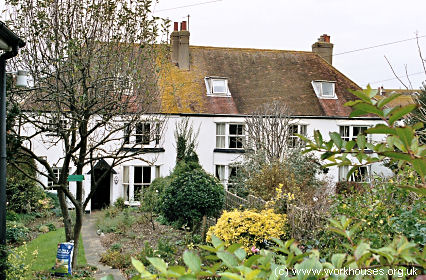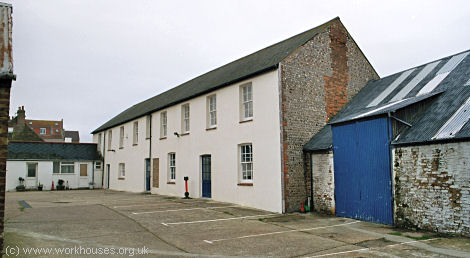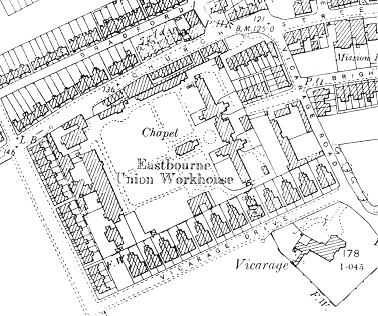Eastbourne, Sussex
Up to 1834
Eastbourne's first workhouse stood on what is now Grove Road. In 1777, it could house fifty inmates. In 1817, it moved to Church Street, into premises built as a barracks during the Napoleonic Wars. Its inmates in 1832 comprised fourteen men, fourteen women, eighteen girls and seventeen boys.
In 1777, parish workhouses also in operation at West Dean (housing up to 18 inmates) and Wilmington (8).
An Eastbourne Gilbert Union was formed in about 1794. In 1817, the Eastbourne Guardians established a workhouse on Church Street in rented premises that had been built as a barracks during the Napoleonic war.
Seaford's parish workhouse was located on Blatchington Road on the site of the medieaval leper hospital of St John's. The master and his assistant resided in Twyne House and Twyne Cottage, while the inmates lived in a long building in the yard behind, now occupied by St James' Trust.

Twyne Cottage (left) and Twyne House, 2004.
© Peter Higginbotham.

Seaford former parish workhouse, 2004.
© Peter Higginbotham.
After 1834
Eastbourne Poor Law Union was formed on 25th March 1835. Its operation was overseen by an elected Board of Guardians, 17 in number, representing its 14 constituent parishes as listed below (figures in brackets indicate numbers of Guardians if more than one):
County of Sussex:
Alfriston, Eastbourne (3), East Dean, West Dean, Folkington, Friston, Jevington, Littlington [Litlington], Lullington, Pevensey, Seaford (2), Westham, Willingdon, Wilmington.
Later Additions: Alciston (from 1898), Berwick (from 1898), Hampden Park (1911-12), Norway (1894-99), Selmeston (from 1898).
The population falling within the Union at the 1831 census had been 7,823 — with parishes ranging in size from Lullington (population 49) to Eastbourne itself (2,726). The average annual poor-rate expenditure for the period 1831-34 had been £11,964 or £1.10s.7d. per head of the population.
The new Eastbourne Board of Guardians retained the existing workhouse for use by the Union and in 1859 finally purchased the site. The main building stood at the west with various outbuildings, including converted stables, situated around the rectangular site. A chapel dating from about 1857 stood at the centre. In 1877, An infectious hospital was erected at the east of the site. It was converted to a infirmary in 1887. Later additions included a Master's house in 1913. In 1927-8, a new ward block was built on the site of the old chapel. The site layout is shown on the 1898 OS map:

Eastbourne workhouse site, 1898.
The workhouse later became St Mary's Hospital. The buildings were demolished in 1990 and the site now contains a housing development.
Children's Home
By the early 1900s, the Eastbourne Union had established a children's home at 2-4 Birling Street, Eastbourne. In 1908, the home could accommodate 20 children, with Miss E. Field as Foster Mother. The property is now in private residential use.
Staff
Inmates
Records
Note: many repositories impose a closure period of up to 100 years for records identifying individuals. Before travelling a long distance, always check that the records you want to consult will be available.
- West Sussex Record Office, County Hall, Chichester, West Sussex PO19 1RN. Holdings include Guardians' minutes (1835-1930); Births register (1908-19); Deaths register (1908-30); Emigrations (1899-1930) etc.
- Eastbourne Library, Grove Road, Eastbourne BN21 4TL. Holdings comprise: Abstract of accounts (1884-1919 - these list residents); Minutes of meetings (1923-29).
Bibliography
- Higginbotham, Peter Workhouses of London and the South East (2019)
- Surtees, J (1992) Barracks, Workhouse and Hospital: the Story of St Mary's Hospital, Eastbourne (1794-1900).
Links
- None.
Unless otherwise indicated, this page () is copyright Peter Higginbotham. Contents may not be reproduced without permission.


